|

“LP’s Gliders” (ca 1930’s) – Shortly after I
informed my wife that I would be collecting “a few vintage gliders” (ha!),
she found this group of small, pre-War gliders stuffed in a shoebox on a
back table of a local antique store. The efforts to identify their origin
jump-started my research into the history of wooden toy gliders. After
years of exploration, I still have not been able to positively identify
them. However, they were among the group of gliders from my collection
that were chosen for exhibition by an upscale Manhattan art gallery in the
summer of 2010. So these plucky little catapult gliders are not only
attractive … but well-traveled. |
|
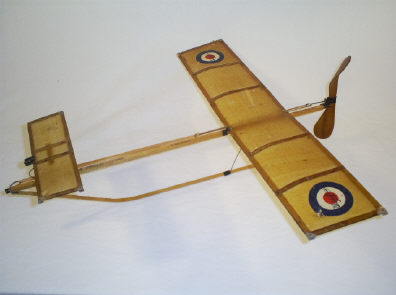
“Warneford Aeroplane” (ca 1915) – The elder statesman
of my collection is this rubber-powered aircraft from England. Like the
first Wright Flyer, the Warneford uses a canard-type configuration … with
a small stabilizer (canard) in front and a large wing at the back. It’s
exquisitely constructed with a wood framework, tiny metal pegs at each
joint and a silk-covered wing & canard. It came fully completed from the
factory … a true RTF airplane. All the owner had to do was to clip on the
wing and canard … wind the prop … and let her go.
I believe this aircraft was named for Flight
Sub-Lieutenant R.A.C. Warneford, who was the first Royal Navy pilot to
receive the Victoria Cross. In June 1915, Warneford attacked and
destroyed the German Zeppelin bomber LZ37. Warneford’s airplane had no
guns. He flew over LZ37 and dropped his small load of bombs directly onto
the airship. Tragically, he lost his life 10 days later while test-flying
an airplane. Flt S-Lt Warneford became a national hero in England. |
|
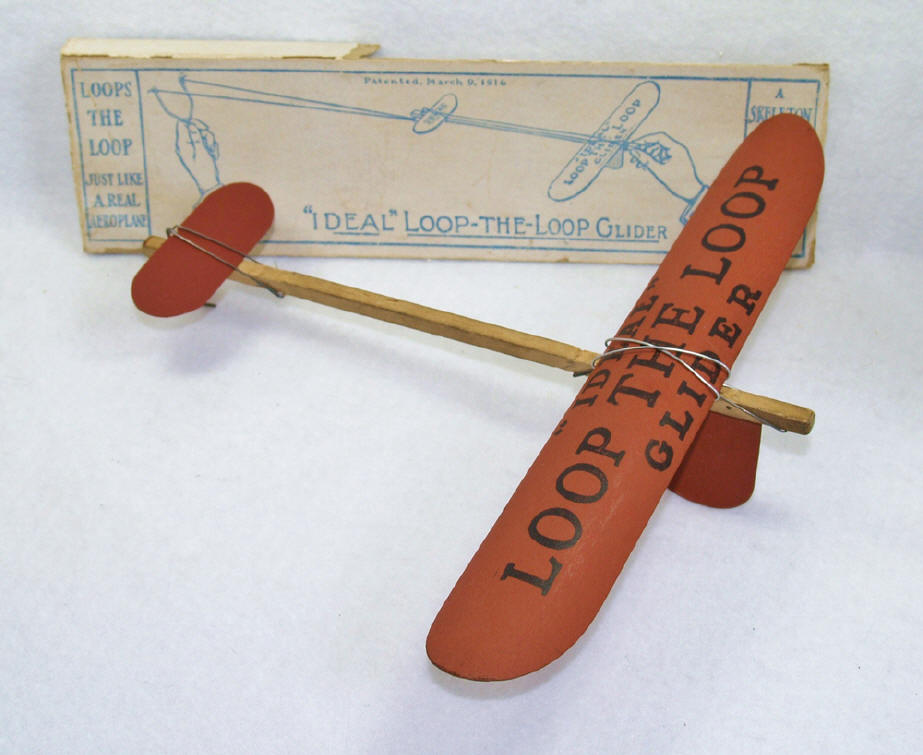
Ideal “Loop the Loop” glider (ca 1920-21) – This
glider was produced by the Ideal Aeroplane & Supply Co (NY) and was one of
the first good performing and relatively affordable ready-to-fly toy
gliders. They appeared in Ideal catalogs as early as 1914. Two versions
of this design were available … one using “fibreboard” for the wing &
canard … and a more expensive version using wood for these components.
This particular example is the wooden version. Founded in 1911, Ideal was
one of the largest producers of model airplane kits and supplies in the US
well into the 1940’s.
The rather complex metal
clip at the front of the glider allows the adjustment of the angle of the
canard. The canard can be set relatively flat for straight-ahead flights,
or progressively angled up for tighter and tighter loops. Initially,
Ideal used rubber bands to secure the wing and canard to the fuselage.
However, they changed to metal clips in 1920 … as with this model … to
better hold these pieces in place. |
|
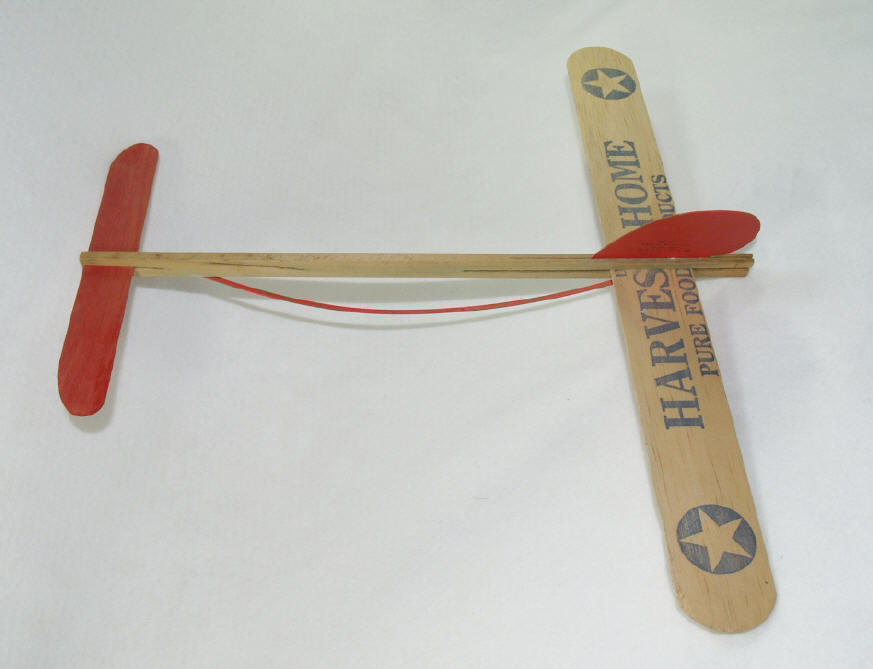
Wanner “No. 180” gliders (1924) – Two of the earliest
sheet-balsa gliders in my collection are these large airplanes from the
George D Wanner Co of Dayton (OH). Another of the canard-configuration
gliders, it has a thickly coated wire skid to smooth out those rough
landings. You can put the canard into the forward position for long, flat
glides or slide the canard into the angled slot to perform loops. Of the
three similar Wanner gliders I’ve found, all had advertising printed on
the wings. The Wanner Company was primarily known for the manufacture of
stick & tissue airplane kits. |
|

Broadfield “American Eagle” catapult launch glider (ca late
1920’s) – The Eagle is another canard configured glider … which were
popular in the 1920’s. The canard sat in a notch that provided several
different degrees of up-angle, depending on whether you wanted long glides
or aerobatic loops. Also included in the original kit was a launch stick
with a lengthy rubber band. The box indicated that you could stretch the
launch rubber out to 8-10 feet or more, to properly launch the glider.
(Wow!) Unfortunately over time, the rubber in my kit had petrified and
broken into tiny bits.
Also notable with this kit was the wonderful artwork
on the box. You can clearly see the two suggested launch methods … the
catapult stick pushed into the ground or the stick being ably held by an
assistant. The box also showed girls enjoying the fun of flying the
Eagle. Imagine that … girls flying airplanes!
The Broadfield Toy Co of Hempstead (NY) was
established in 1919. Ads for their flying toy airplanes appeared in “The
American Boy” magazine in the 1920’s. Broadfield sold everything from
airplane plans and parts, to complete kits and RTF airplanes. Prices
ranged from 25 cents to $10 … not inexpensive in those days. |
|


Broadfield glider No.54 “Smiling Jack” (ca 1930’s) –
This unusual mid-size glider (12 inch wingspan) was undoubtedly an homage
to intrepid pilot Jack Martin of the comic strip “The Adventures of Smilin’
Jack”. The comic strip, created by cartoonist and pilot Zack Mosley, made
its debut in the Chicago Tribute on October 1, 1933 and ran for 40 years.
(An example of a comic strip from 1934 can be viewed below.) The Smilin’
Jack character also flew into comic books and onto a radio show sponsored
by Tootsie Roll candy.
Aside from his great success as a cartoonist, Zack
Mosley was a co-founder of the Civil Air Patrol. He received a USAF air
medal for flying patrol missions off the Atlantic coast during the early
months of WW2, and in 1976 was inducted into the Civil Air Patrol–USAF
Hall of Honor. I’m certain his own flying experiences provided the basis
for some of the exploits of Smilin’ Jack Martin, his fictitious hero.
The Smiling Jack glider came in a heavy paper
envelope for the standard Broadfield No. 54 glider. The envelope has
detailed assembly instructions, flying “tips” and imaginative drawings of
children playing with their sailplanes. In addition, the smaller Baby
Hawk glider (10 inch wingspan) was included in the same envelope when I
got it. Since the wing printing was done in the same orange color, these
two gliders could have been intended as a set. (Perhaps they were a
promotional or mail-in item for the radio show.)
Although Broadfield gliders may not have been the
best flyers of their day, the packaging was unmatched for its detailed
information and fanciful artwork. As seen with these gliders (and the
Spirit of St Louis glider elsewhere in this section) Broadfield used
colorful markings to honor aviation heroes of the period. Clearly these
toys were not intended to be accurate depictions of aircraft made famous
by these aviators … that was left to the imagination of the lucky
kids who got them. But they were still something very special for the
youngsters … and now, small reminders of a bygone era for us.

Click on this thumbnail to see a larger
image of this comic strip |
|

“Boomerang Plane” (ca 1930’s) – This unusual bi-plane
catapult glider is attributed to the Brown Manufacturing Co of Clinton
(MO). Not only are two identical wings used on the glider, but a small
rubber catapult is incorporated into the rubber nosepiece. As its name
“promises”, if you adjust the wings properly it will (may?) return to your
general location after being launched.
Brown Mfg produced a variety of toys and games in the
1920’s and 30’s. Company founder Lawrence Brown is said to have been
instrumental in popularizing the game of Chinese Checkers in the US. Some
of the company’s game boards use similar patterns and printing colors that
you see on this strange little airplane. |
|

Continental “Minit-made Flyer” ROG (ca 1940’s) –
Known primarily for its line of solid wood model kits, the Continental
Model Aircraft Co produced this purposeful looking ROG in the late
1940’s. The printing on the wing is very striking, however the mis-matched
printing on the tail components gives the impression that they are from
Continental’s “parts bin”. |
|

Cleveland “Mustang” ROG (ca late 1940’s) – This
beautifully made ROG was the only rubber-powered RTF airplane sold by the
legendary Cleveland Model & Supply Co of Cleveland (OH). According to
company sources, it was only made for a short period of time. Relatively
few of these Mustangs are known to have survived to this day.
Cleveland is reported to be the oldest continuously
surviving model airplane company in the world. Impeccable engineering and
use of the finest materials were the hallmarks of the company’s pre-War
and immediate post-War kits. Sadly, Cleveland now sells only the plans
for its magnificent aircraft. They haven’t produced any kits in decades. |
|

Pactra “Super Saber” ROG (ca late 1960’s) – After
absorbing American Junior Aircraft in 1963, Pactra still used the Jim
Walker name extensively on packaging for a number of years. However, by
the time this ROG came out, the Jim Walker name had been omitted … the
former AJ Portland factory had been closed … and the glider production had
moved to Los Angeles (CA). The Super Saber was clearly based on the AJ
Space Kadet. But purple? Really … purple? |
|
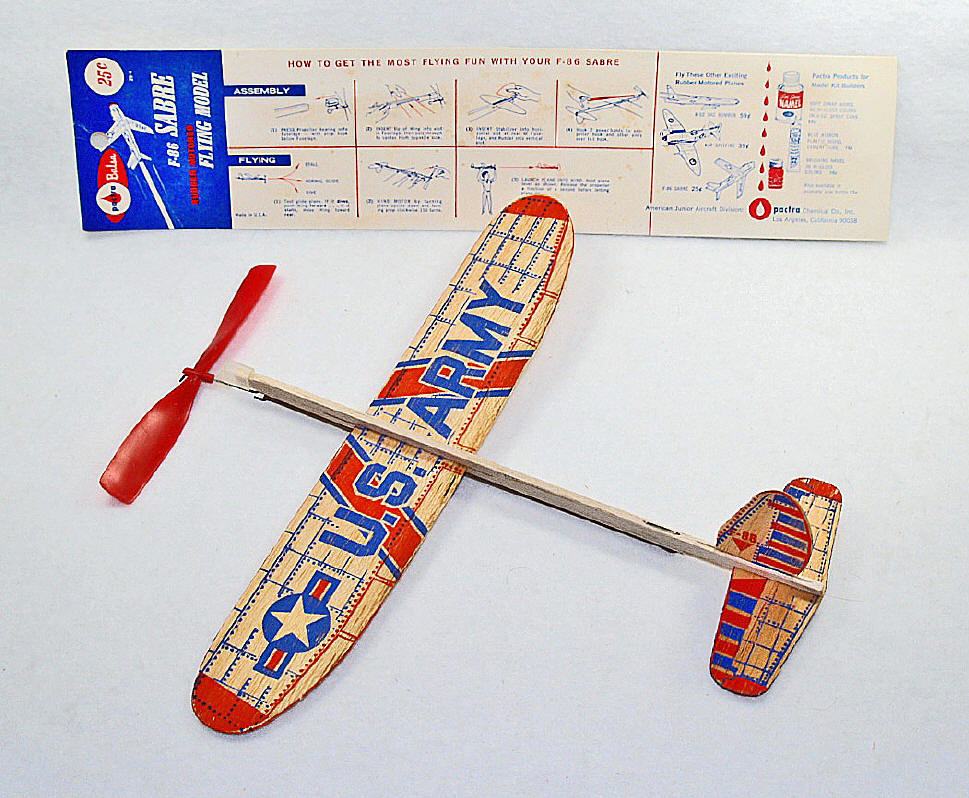
Pactra “F86 Sabre” (ca early 1970’s) – This was a
surprising find for me on a couple levels. Surprising that this
rubber-powered airplane had balsa wings & tail-fins in a sea of Pactra RTF
aircraft that now were mostly made of foam, and surprising that Pactra
chose to use a rather spectacular and multi-colored “US Army” motif on a
F86 jet glider made in the 1970’s. Given the badly sagging market for
wood gliders, this WAS a really good effort on Pactra’s part to make an
attractive and good-flying balsa airplane once again. |
|

Top Flite “Jet 80” toss glider (ca 1970’s) –
Seemingly a late entry to the “toy” glider market, Top Flite produced this
rather nice looking glider as part of a relatively large RTF product
line. However, with no airfoil and virtually no dihedral, it was probably
a marginal performer (except indoors). The quality of the balsa was also
quite low.
After his ground-breaking design work with the Comet
Model & Supply Co, model airplane Hall-of-Famer Carl Goldberg and two
partners founded American Hobby Specialists in 1945 to primarily produce
model airplane propellers. They expanded their product line and renamed
the company Top Flite in 1947. The company became famous for its series
of Jigtime model kits, which used pre-printed balsa pieces with cleverly
designed slots and tabs for ease and correctness of assembly. Goldberg
left the company in 1955, and by the 1970’s TF was aligned with the
Crunden Martin Co of St Louis (MO). |
|

Top Flite “P88 Hornet” ROG (ca 1970’s) – Virtually
identical to the Pactra Super Saber in design and packaging, the P88 also
used the old AJ “Hornet” name. By this time, Top Flite apparently had
purchased the tooling and design rights for much of the Pactra (American
Junior) RTF product line. The company even continued to produce the Super
Saber as a wheel-less, rubber-powered glider. (And yes … they produced it
in purple just like Pactra did!) The complex lineage of many of these
“toy” aircraft is truly amazing at times. |
|
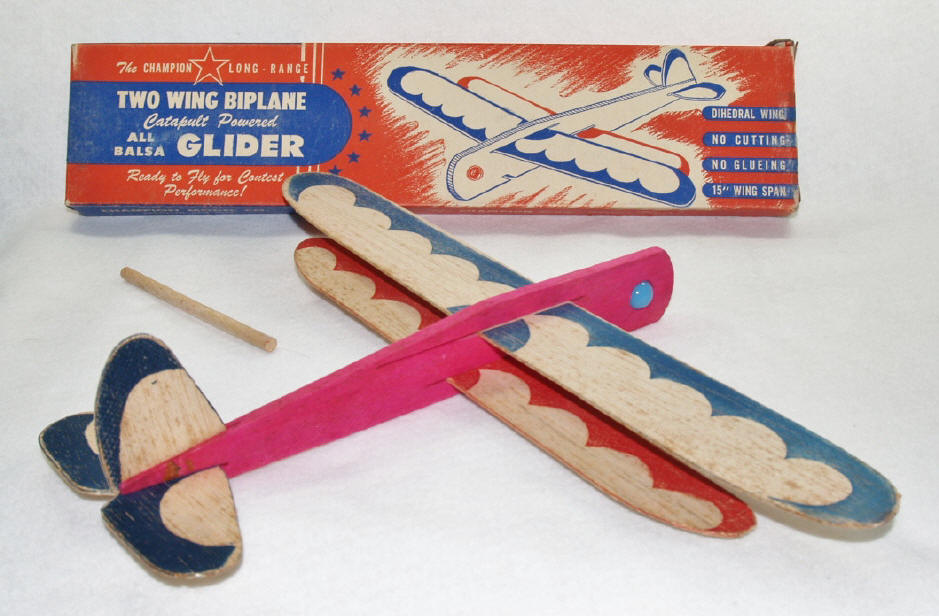
Champion “Two Wing Biplane” catapult glider (ca
1940’s) – Admittedly, I don’t know what design feature on this glider is
more strange … the dragonfly-type wing configuration, the blue marble nose
weight or the pink fuselage. (And are there any one wing biplanes?)
Despite what the package says, I couldn’t detect any wing dihedral, and
wonder if this glider actually has any real “contest performance” in its
DNA. I would say this product is definitely in the “toy” category. The
Champion Model Co was in the model airplane business from about 1935 to
1966.
|
|

Cleveland “Cloud King” towline glider (ca 1949-52) -
The largest vintage RTF glider in my collection is this magnificent
towline glider from the Cleveland Model & Supply Company. With a wingspan
of 36 inches, it dwarfed just about every other RTF “toy” glider of its
day. By comparison, the AJ Army Interceptor glider seen in the photo with
the Cloud King (and seen in the American Junior section of this article)
has an 18 inch wingspan.
Despite this glider’s large size, assembly is
amazingly fast and simple. The wings slide easily into the one-piece
metal wing support. The small metal tabs are bent down to secure the
wings in place. The wing support was fabricated to provide both dihedral
and airfoil shaping … enhancing the efficiency of the airfoil-steamed
wings. After you attach the completed wing assembly onto the fuselage,
just slip the tail components into their respective slots and you are
ready for flight.
I assume Cleveland intended the glider to be launched
via a towline rather than using a hand-held catapult stick. The Cloud
King is just too large for any catapult stick to be very effective.
After its completion, this particular glider sat on a
shelf for about 40 years in the office complex of Cleveland’s legendary
founder Ed Packard. Mr. Packard gave the glider to a company guest in
1991, as Cleveland employees were preparing to relocate business
operations to a much smaller facility. The Cloud King is a marvel of
engineering and manufacturing expertise ... hallmarks of Ed Packard’s
iconic company.

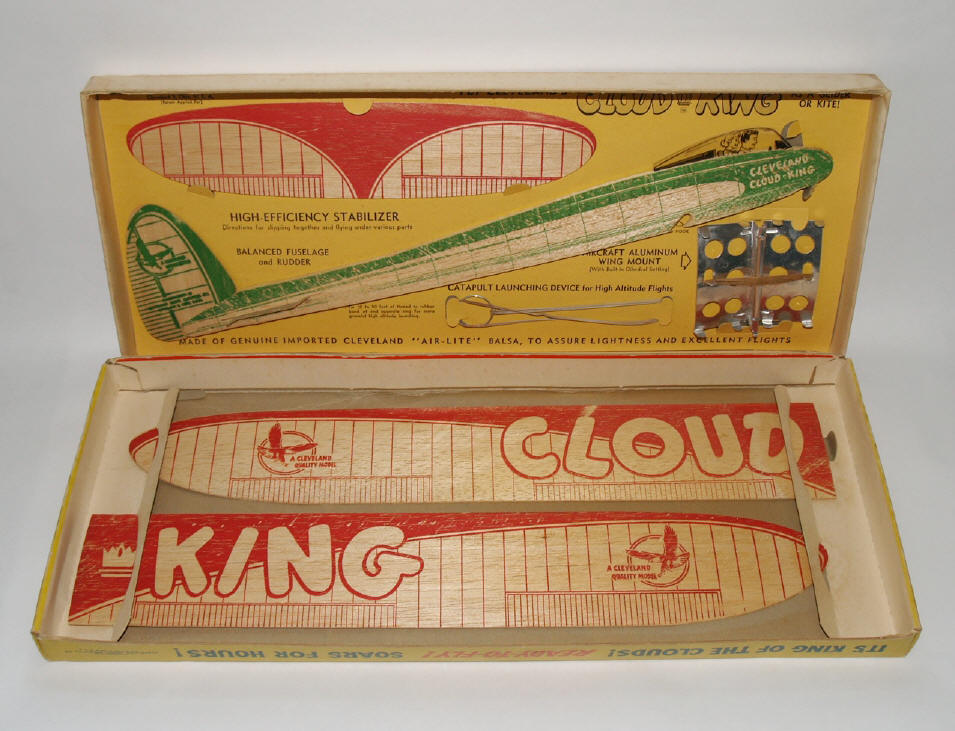
|
|
Stanzel “Aeromic Streak” toss glider (ca 1960’s) –
Manufactured in Schulenburg, Texas by Victor Stanzel & Company, this
plastic and balsa glider probably had difficulty competing with the
all-wood gliders in its 15 inch wingspan class. With a somewhat heavy
(but durable) plastic fuselage and no wing dihedral, its performance was
undoubtedly a bit lacking. This example was clearly flown several times …
showing some wing damage. But its owner appeared to have quickly given up
on it and placed it back in its box, where it has remained to this time.
The Stanzel Company was most respected for their
gas-powered, control line kit airplanes of the 1940’s and 50’s, but most
remembered for their mass-produced plastic toys in the post-1950 period.
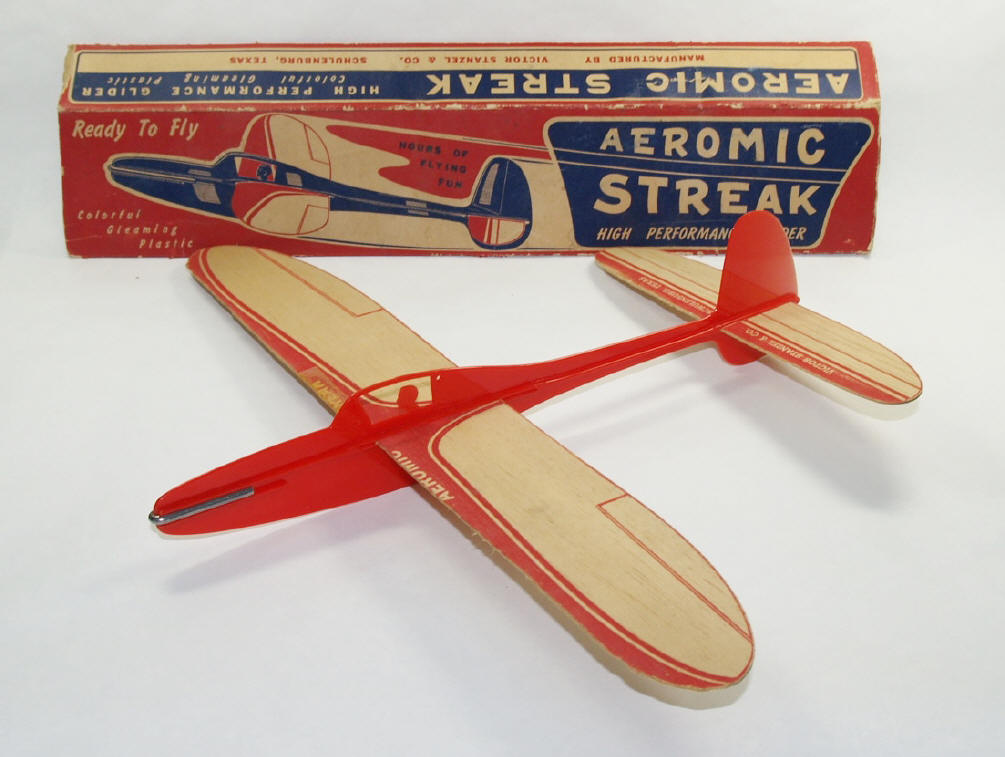
|